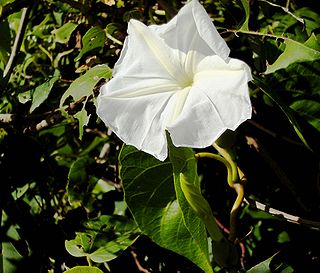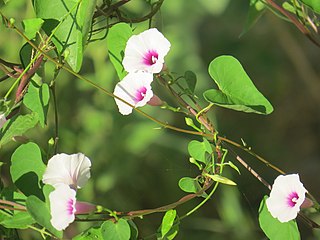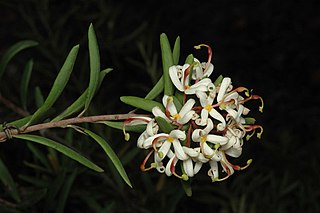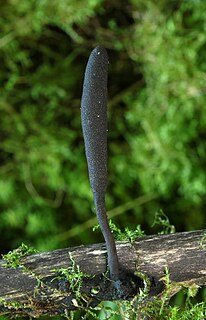
Morning glory is the common name for over 1,000 species of flowering plants in the family Convolvulaceae, whose current taxonomy and systematics are in flux. Morning glory species belong to many genera, some of which are:

Ipomoea is the largest genus in the flowering plant family Convolvulaceae, with over 600 species. It is a large and diverse group, with common names including morning glory, water convolvulus or kangkung, sweet potato, bindweed, moonflower, etc.

Ipomoea aquatica is a semi-aquatic, tropical plant grown as a vegetable for its tender shoots and it is not known as to where it originated. This plant is known in English as water spinach, river spinach, water morning glory, water convolvulus, or by the more ambiguous names Chinese spinach, Chinese watercress, Chinese convolvulus or swamp cabbage, or kangkong in Southeast Asia and ong choy in Cantonese.

Jalap is a cathartic drug, largely obsolete in Western medicine, consisting of the tuberous roots of Ipomoea purga, a convolvulaceous plant growing on the eastern declivities of the Sierra Madre Oriental of Mexico at an elevation of 5,000 to 8,000 feet above sea level, more especially about the neighbourhood of Chiconquiaco on the eastern slope of the Cofre de Perote in the state of Veracruz.

Ipomoea alba, sometimes called the tropical white morning-glory or moonflower or moon vine, is a species of night-blooming morning glory, native to tropical and subtropical regions of North and South America, from Argentina to northern Mexico, Florida and Puerto Rico. Though formerly classified as genus Calonyction, species aculeatum, it is now properly assigned to genus Ipomoea, subgenus Quamoclit, section Calonyction.

Ipomoea purpurea, the common morning-glory, tall morning-glory, or purple morning glory, is a species in the genus Ipomoea, native to Mexico and Central America.

Ipomoea violacea is a perennial species of Ipomoea that occurs throughout the world with the exception of the European continent. It is most commonly called beach moonflower or sea moonflower as the flowers open at night.

Ceratocystis fimbriata is a fungus and a plant pathogen, attacking such diverse plants as the sweet potato and the tapping panels of the Para rubber tree. It is a diverse species that attacks a wide variety of annual and perennial plants. There are several host-specialized strains, some of which, such as Ceratocystis platani that attacks plane trees, are now described as distinct species.

Ipomoea asarifolia, the ginger-leaf morning-glory, is a species of plant in the family Convolvulaceae, of the genus Ipomoea.

Ipomoea amnicola is a species of plant in the bindweed family, Convolvulaceae. It is commonly called redcenter morning-glory. It is found in Mexico, much of South America and has been successfully introduced in the US states of Arkansas, Missouri and Texas.

Ipomoea lacunosa, the whitestar, white morning-glory or pitted morningglory, is a species that belongs to the genus Ipomoea. In this genus most members are commonly referred to as "morning glories". The name for the genus, Ipomoea, has root in the Greek words ips and homoios, which translates to worm-like. This is a reference to the plant's vine-like growth. Lacunosa comes from a Latin word meaning air spaces, correlating with the venation of the leaves. Ipomoea lacunosa is native to the United States and grows annually. The flowers of this species are usually white and smaller than most other morning glories.

Synaphea spinulosa is a species of small shrub in the flowering plant family Proteaceae. It is endemic to Western Australia. Together with Acacia truncata, it was the first Australian endemic to be scientifically described and named, and the specimen upon which that description is based is the oldest extant specimen of an Australian plant, and very likely among the first Australian plant specimens ever collected.

Lomatia tinctoria, commonly known as guitar plant, is a shrub to about 2 metres tall of the family Proteaceae. It is one of three species of Lomatia endemic to Tasmania, the others being L. polymorpha and L. tasmanica. Lomatia tinctoria is closely related to L. polymorpha, with which it sometimes hybridises. Its leaves are divided, while those of L. polymorpha are simple.

Lomatia polymorpha, commonly known as mountain guitar plant, is a shrub or small tree of the family Proteaceae which is endemic to Tasmania. It is a shrub or small tree with linear leaves, and white, cream-coloured or greenish flowers. It is common throughout its range which is approximately complementary to that of L. tinctoria in Tasmania.

Ipomoea oenotherae is a species of plant of the morning glory genus, Ipomoea, in the family Convolvulaceae. It derives its name from the resemblance it bears to plants in the genus Oenothera. Ipomoea oenotherae is a succulent and a cryptophyte.
I. polymorpha may refer to:
Ramalina polymorpha is a strap lichen species. It regularly occurs in both Canada and the United States. The oxidative and cytogenetic effects of R. polymorpha water extract when introduced into human blood cells has been studied for potential use in the pharmaceutical industry or as a dietary supplement.

Xylaria longipes, commonly known as dead moll's fingers, is a species of fungus in the family Xylariaceae.
Synaphea polymorpha, commonly known as Albany synaphea, is a species of small shrub in the flowering plant family Proteaceae. It is endemic to Western Australia. The Noongar peoples know the plant as bindak.
















